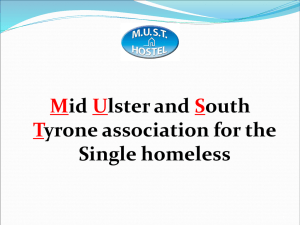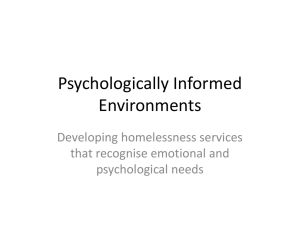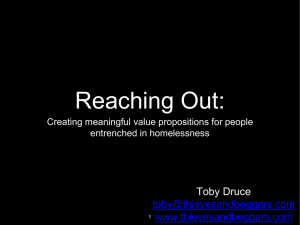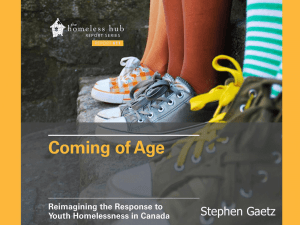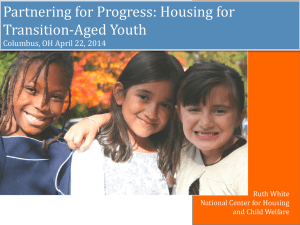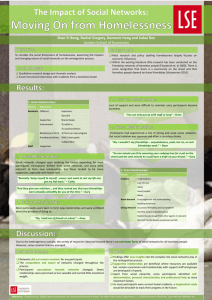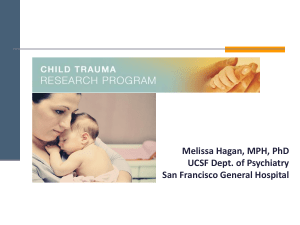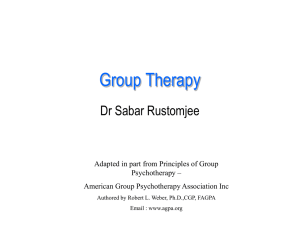Psychologically informed environments - Harry Shapiro
advertisement
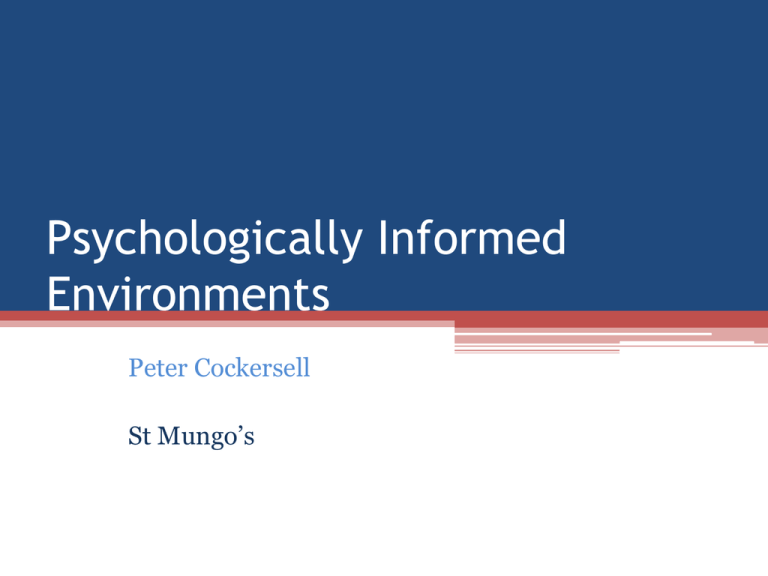
Psychologically Informed Environments Peter Cockersell St Mungo’s 2 Tackling homelessness and exclusionunderstanding complex lives • The report looked at 4 research programmes commissioned as part of the Multiple Exclusion Homelessness (MEH) Research Programme, which ran form Feb 2009 to Sept 2011. • Fitzpatrick et al., Heriot-Watt University • Cornes et al., King’s College London • Dwyer et al., University of Salford and Nottingham Trent University • Brown et al., University of Salford and University of Lincoln 3 The main findings • Nearly half of services users reported experiences of institutional care, substance misuse and street activities such as begging as well as homelessness. • Using hostels or making homelessness applications commonly happened after contact with non-housing agencies such as mental health services, the criminal justice system and social services. • Traumatic childhood experiences and later self harm and suicide attempts in adulthood were a commonly reported factor. • Housing and hostel staff often take the primary responsibility for supporting people with multiple and complex needs, often without support. 4 These tell us three important things 1. Some clients using non-housing services will go on to rough sleep and staff in these services need to be able to recognise those at risk, and know where and how to make appropriate referrals. 2. The impact of early childhood trauma must be explicitly acknowledged by both housing and non-housing service providers and included in the assessment process. 3. Housing and hostel/floating support/day centre staff should be trained and supported to work with clients with multiple and complex needs. St Mungo’s • About 2000 beds: hostels to self-contained flats, including registered care • Specialised drug, alcohol, mental health, dual diagnosis; older, women’s, and sexworkers’ projects • Street outreach, 2 day centres, employment, training, substance use, health, and psychotherapy • London, Reading, Oxford, Bath and Bristol St Mungo’s clients • 61% substance dependency/ies • 69% mental health problems • 46% substance dependency and mental health problems • 34% substance dependency, mental health and physical health problems (Client survey 2009) St Mungo’s clients’ childhoods • 47% experience of neglect/emotional abuse • 34% early loss of parents through abandonment, separation or divorce • 31% early loss of parents through death (including murder and suicide) • 27% sexual abuse • High levels of parental alcoholism, drug use, and domestic violence Impact of Trauma Homeless General • Personality disorders: 60-70% (So’ton University, 2009; Oxford University, 2008) • Personality disorders: 5-13% (DH, Recognising Complexity, 2009) • Psychotic illnesses: 31% (SLaM, 1989; CHAIN, 2010) • Psychotic illnesses: 0.4% (NHS Information Centre, 2008) • Anxiety/depression: 50-80% (Oxford University, 2008) • Anxiety/depression: 17.6% (NHS Information Centre, 2008) Behaviours associated with Complex Trauma • Self-harm • Uncontrolled drug or alcohol use • Impulsive, careless of the consequences • Withdrawn, reluctant to engage • Anti-social • Isolated • Aggressive • Lacking daily structure or routine • Inability to sustain work or education • Bullying, or being a victim • Offending • Unstable relationships Catalysing Change: Theory • Negative internal working models (Bowlby) • Insecure attachment paradigms (Bowlby) • Damaged affect regulation (Schore) • ‘Frozen’ cognitive responses and coping strategies (Siegel) Catalysing Change: Practice • Recovery approach – positive regard and positive aspirations • Respect and intensive engagement • Individualised approach to problem-solving – Outcomes Star • Multiple options • Psychologically informed environment • Psychotherapy Origin of PIEs • Robin Johnson and Rex Haigh developed ‘enabling environments’ • PIPEs developed in criminal justice system • PIEs developed in community • Helen Keats (DCLG), Nick Maguire (Southampton Uni), Robin Johnson (RJA Consultancy), Peter Cockersell (St Mungo’s and Homeless Healthcare CIC) What is a PIE? • Hostels and day centres are highly managed and reactive environments focusing on risk assessment and crisis management. This has an impact on client outcomes. • PIEs will identify, adapt and consciously use the managed environment to focus on the psychological and emotional needs and capacities of clients in a positive way • PIEs use a therapeutic framework to develop clear and consistent responses to clients • PIEs are not simply about containing challenging behaviour, but changing it; they create an empowering and calming environment where people can feel emotionally as well as physically safe, and can gain an understanding of their behaviour and an ability to take responsibility for themselves • Reflective practice, and effective supervision, are essential • Psychologically aware housing services are not a replacement for clinical services; health commissioners should be involved to ensure that people with complex trauma, and including those with dual diagnoses, have accessible and appropriate clinical services Key Ingredients A Psychological Framework Social Spaces Staff Training and Support Managing Relationships Evaluation of Outcomes Key Ingredients Psychological Framework • Cognitive Social Spaces • Remodelling is not essential! • Psychodynamic • Welcoming and noninstitutional • Eclectic • Encourage interaction • Safe movement, and safe meeting spaces Key Ingredients • • • • • Staff Training and Support Reflective practice Good supervision Client involvement Ongoing evaluation Corporate theoretical framework and approach • • • • • Managing Relationships Consistent boundaries, sanctions and rewards Pro-social modelling Awareness of power Positive regard Psychological and emotional awareness PIE Pilots Old and Crusty Just Baking • Mental Health projects • Brent Dual Diagnosis • Rolling shelter • Access hostel • Lifeworks Psychotherapy Service • Women’s project • London and Bath Psychological Framework Psychodynamic (Shedler) Attachment Cognitive Recovery Staff support and training • • • • Clinical supervision Client access to psychotherapy Reflective practice Training: Attachment, etc: psychological perspectives Motivational interviewing, etc: psychological techniques The Escape Plan: client perspectives Recovery Leadership & Performance Management • Corporate Commitment and Framework Managing Relationships • Complex trauma arises from abusive relationships • Healing relationships need to be managed, and take care, and time • Relationships have an impact on both/all parties • Group dynamics affect individual group members’ relationships • Setting up PIEs is also about managing relationships Brent Dual Diagnosis and Lifeworks Brent DD • Psychotherapist and specialist SU Worker as part of team • Clients discharged from hospital with severe and enduring mental illness and substance dependency Lifeworks • Individual psychodynamic psychotherapy • Statutory and voluntary sector referrals at 8 sites; ‘chronically excluded adults’ • Reflective practice • 67% engagement (4+ sessions) (IAPT, 38%); 75% positive outcomes MWIA measure (IAPT, PHQ9, 44%) • Groups, 1-1’s, individual therapy • 100% increased positive outcomes on Outcome Star • No rehospitalisations • 3X more likely to go from precontemplative to active • 17 of 18 positive moves to less supported housing • 42% employment/training placements Client Testimony 1 • I was drinking and using drugs for a long time, I used to work in the music business but lost it and ended up sleeping rough. I had a lot of family problems and for a long time, thought it was all my fault. Through my work with Life Works I now know it wasn’t just me, it was all of us, none of us are perfect. May be if my parents had used this service things may have turned out different. I think it could have helped them. I now realise that the drink, the drugs, (losing) the flat, the family, it’s all linked. I think I need more (therapy), I wish I was still there (Life Works). If it wasn’t for them I’d be dead by now, no word of a lie. 22 Client Testimony 2 • I didn’t want to go initially, thought I didn’t need to see a shrink. I gave it a go and the first few sessions were very informal, unthreatening. I grew to trust her, told her things I haven’t told anyone else. A lot of tears were shed, she didn’t drag it out of me, she listened. I got shit out of my system that I’d been carrying around a long time. There was an underlying burden in my heart that she knew what to do with. Everything I said wasn’t written down and I loved that. It was properly confidential. It was a hard one but it was a good one and if it wasn’t for her I’d be floating down the Thames now. 23 More reading • Cockersell P (2011a) Homelessness and mental health: adding clinical mental health interventions to existing social ones can greatly enhance positive outcomes, in Journal of Public Mental Health, 10(2), 88-98 • Cockersell P (2011b), More for Less? Using PIEs and Recovery to Improve Efficiency in Supported Housing, Housing, Care and Support Journal, 14(2), 45-51 • Maguire NJ, Johnson R, Vostanis P, Keats H, and Remington RE, (2009) Homelessness and Complex Trauma: A review of the literature. Southampton: eprints.soton.ac.uk • Johnson R and Haigh R (2011), Social Psychiatry and Social Policy in the 21st Century: new concepts for new needs – the ‘Enabling Environments’ initiative, Mental Health and Social Inclusion, 15(1) 17-23 Further Information • Operational Guidance will be published in the new year by Homeless Healthcare CIC, Southampton University, RJA Consultancy • There is a PIE group on LinkedIn • Contact me: peter.cockersell@mungos.org
